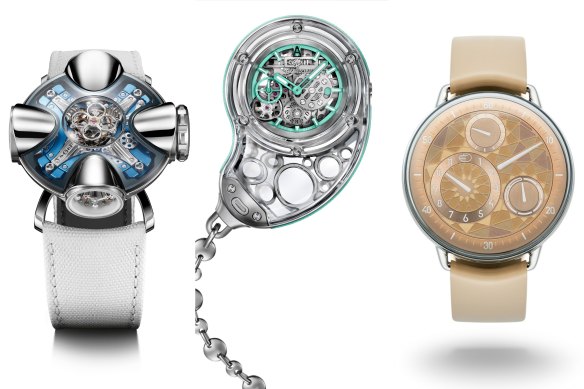This was published 10 months ago
While most watch designers remain gripped by nostalgia, some are dialling it up
In an industry fixated by heritage reissues and anniversary special editions, a few plucky brands are attempting to look to the future.
By Luke Benedictus
It’s a truth universally acknowledged that if you want to know what a journalist looked like eight years ago, just take one look at their picture byline. Obviously, I’m guilty of this minor deception myself. But my adherence to an old photo isn’t just to stop readers from choking on their cornflakes.
The bigger reason, of course, is vanity. Eight (all right, 10) years ago, I didn’t have these sagging jowls or that haggard air of doomed resignation.

Innovative outliers in a nostalgia-fixated industry, from left: the MB&F HM11 Architect, Hublot Arsham Droplet, and Ressence Type 1˚ Round DX3.
Somewhat ironically, given their line of work, brands that make mechanical watches also harbour aesthetic objections to the passage of time. The most sought-after models in the world – the ones that require multi-year waiting lists or special connections to buy – were first released decades ago.
Take the Rolex Cosmograph Daytona (1963), Audemars Piguet Royal Oak (1972) or the Patek Philippe Nautilus (1976), to name but three. Sure, there may have been subtle refinements to these models over the years in the form of upgraded movements, new bracelets or tweaked case sizes, but the basic source material remains the same. That watch brands remain utterly fixated by the past is demonstrated by the endless production of heritage reissues and anniversary special editions.
What’s surprising about this preoccupation is that it’s not as if the watch industry is moribund.
Indeed, last year, exports of Swiss watches exceeded $US30 billion (about $45 billion). Yet despite all the investment pumped into new watches, nostalgia is still the primary driver of horological design. A few plucky brands – like the ones pictured here – do attempt to look to the future. Some boldly take the watch into a more sci-fi direction, reinterpreting it as some mad form of alien spaceship for the wrist. But while such ingenuity tends to be politely applauded, it remains an outlier at best. Consumer demand for radical innovation simply isn’t there.
This, I suspect, is because a mechanical watch is an increasingly anachronistic device anyway, particularly in the age of the smartphone. And if you’re buying into a bygone era, you might as well get the period details right. “You can’t repeat the past,” as F. Scott Fitzgerald once wrote. But you can always get a modern remake with a different coloured dial.
To read more from Good Weekend magazine, visit our page at The Sydney Morning Herald, The Age and Brisbane Times.